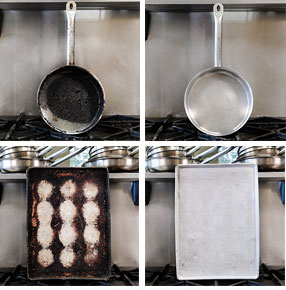Q. How long must items remain in the Spectank®?
This depends on the item but generally between 20 minutes and 24 hours (items should not be left in the tank for longer than 24 hours). Items should be removed, thoroughly washed and rinsed and put back in the Spectank® if required. Heavily carbonized or greased-up items will initially require a longer soak time. Your kitchen will become progressively cleaner as the Spectank® is put to work over time.
Q. How often should items be cleaned in the Spectank®?
This will vary depending upon the usage of the utensils and equipment. The amount of fat, grease and carbon build-up will also dictate how often things are cleaned in the Spectank®. It is recommended that a schedule be drawn up to ensure that the utensils and equipment get cleaned on a regular basis. The Spectank® system should be in constant use.
Q. What items cannot be cleaned in the Spectank®?
It is not recommended to put silver, silver plate, tin plate, enamel coated pots, teflon, silicone coated pans, wood or thin plastic items into the Spectank®.
Q. What is the detergent used in the Spectank®?
It is a mixture of Carbsolve®, a proprietary mix of 13 chemicals to aid in decarbonising, and water.
Q. Can I put aluminum in the Spectank®?
Yes, Carbsolve® is tested non-corrosive to aluminum.
Q. How often does the water need to be changed in the Spectank®?
The solution in the tank including the Carbsolve® will last for a month at a time, only the surface needs to be “skimmed” every few weeks to remove surface fats and oils if necessary.
Q. Will Carbsolve® damage silicon or teflon coatings?
Items left in the Spectank® longer than 24 hours and cleaned too often will over time lose their coating. Items already damaged and placed in the Spectank® will cause the chemical to “lift” coatings away from the metal surface.
Q. Will the solution kill bacteria?
As the Spectank® system runs at over 88°c, all harmful bacteria will die in the Carbsolve® solution, so all items removed from the Spectank® will be sanitized.
Q. Is the solution sate to dispose of in the drain?
Yes, the solution is biodegradable. There are no harmful chemicals and it is broken down into organic material.
Q. Can I still use the solution after it is cooled down and has been reheated?
Yes. But care should be taken not to allow the liquid to cool down as to reheat it to the operating temperature will take time.
Q. Should the electricity supply be disconnected under normal use?
Even at times when you have nothing in soak, you should keep the power switched on. To reheat the solution to operating temperature will cost considerably more in electricity than maintaining the temperature.
Q. What is the residue that sometimes stays on the equipment?
In certain areas with very hard water, the liquid can react with the calcium in the water, and leave a residue on the equipment being cleaned. This residue is harmless.
Q. What safety wear should be used?
We always recommend using heat resistant rubber gloves, safety goggles and an apron when loading or unloading the tank with utensils.


